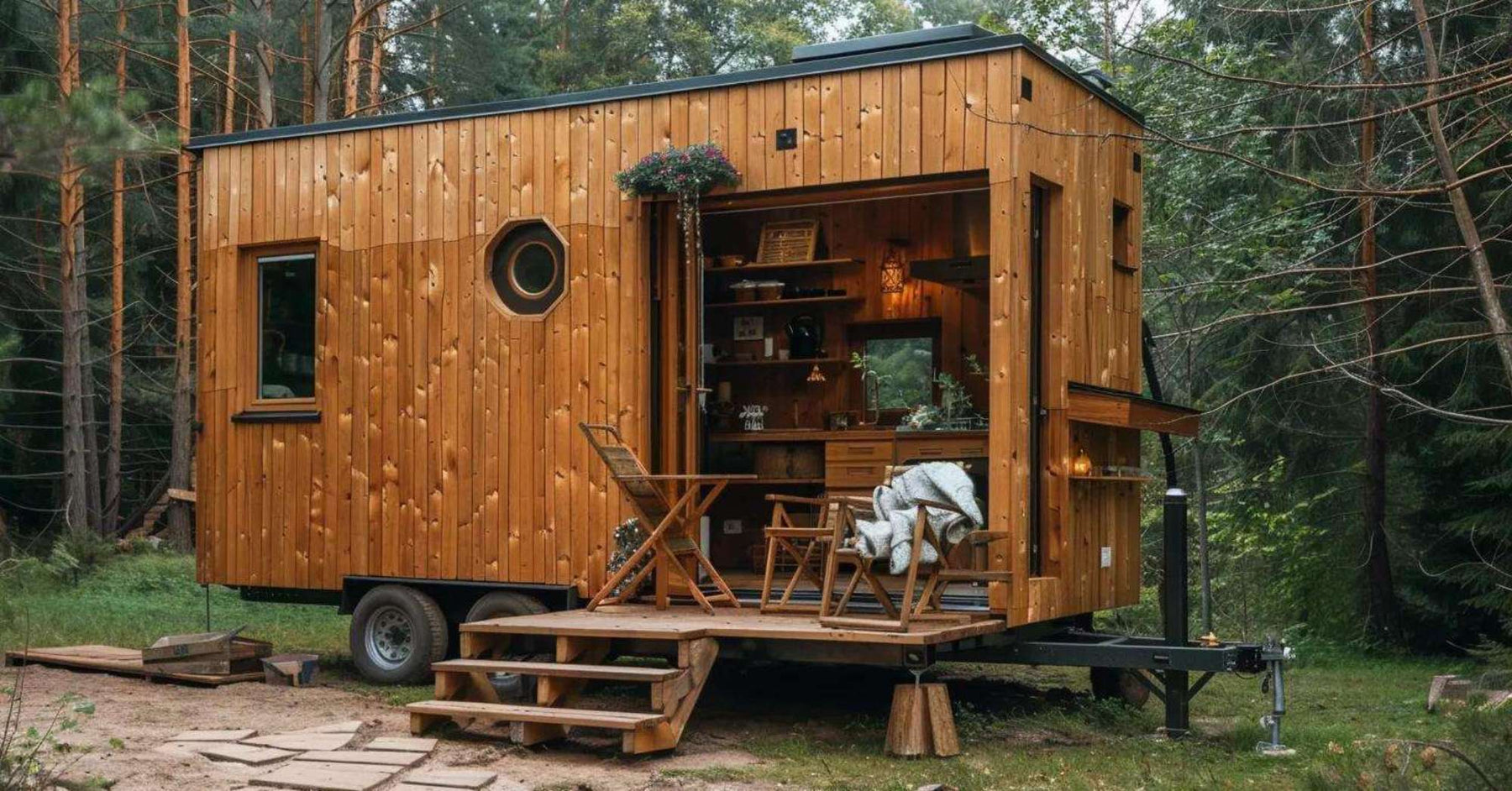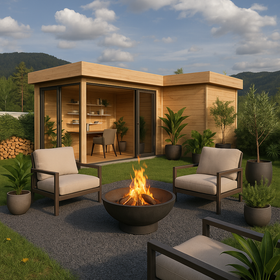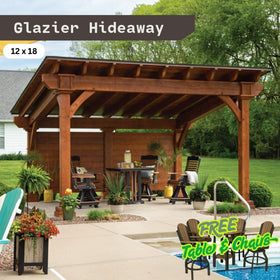512-777-0154

Where Can I Put a Tiny Home?
So, you’ve fallen for tiny living. You’ve seen the YouTube tours, scrolled through dreamy photos, and now you’re ready to ask the big question: where can I actually put a tiny home?
Short answer: almost anywhere that welcomes small spaces and big dreams: your own land, a tiny home community, or off-grid hideaways.
The trick is understanding the rules that come with each. Let’s make sense of it all.
1. Zoning & The Law: The Most Important First Step
Before setting up your GardenHouse24 USA Arhus 70 Tiny Home, zoning laws need to be your first stop. What’s legal in one town might be banned in the next.
Understanding the rules early can save you months of frustration, not to mention money and fines.
Tiny Homes on Wheels (THOW) vs. Foundation-Built Homes
Tiny homes come in two main types: those on wheels and those on foundations. Both are great, but they fall under very different laws.
A Tiny Home on Wheels (THOW) is typically classified as a recreational vehicle. It’s mobile and flexible but not always recognized as a permanent dwelling. Some areas let you park them on private land or in RV parks, while others restrict full-time living.
A foundation-built tiny home is treated like a regular house. It’s easier to insure, finance, and sell later, but you’ll need to follow all local building codes and inspections.
The Legal Classification Crisis: RV, Park Model, or Dwelling?
This is where many people get confused. A tiny home can fall into different categories, RV, Park Model, or Dwelling, depending on how it’s built and used.
Each classification changes your tax status, insurance needs, and where you can legally live. Getting it right before you build can save you major headaches later.
The ADU Solution: Adding a Tiny Home to Your Existing Property
If you already own a home, adding a tiny one to your property could be easier than you think. These are called Accessory Dwelling Units (ADUs), and many cities now encourage them.
ADU laws vary, but most require you to follow setback limits, height restrictions, and occupancy rules. They’re perfect for guest houses, rental income, or extra family space.
Connecting your tiny home to your existing water, sewer, and electric systems makes things easier and more affordable. Just remember, permits are a must. If your land is rural, you may need to set up your own septic or well system.
The Zoning Barrier: Minimum Square Footage Requirements
Some towns still cling to outdated rules about minimum house size, often 1,000 square feet or more. That’s bad news for anyone who loves compact living.
The good news? You can sometimes request a variance from your local planning department. If you can show your home meets health, safety, and structural standards, there’s a good chance they’ll approve your project.
2. Tiny Homes on Your Own Land: The Independent Route
Owning your own land gives you freedom and control, but it also means handling zoning, utilities, and infrastructure yourself.
If that sounds exciting instead of overwhelming, the independent route might be for you.
Finding "Tiny Home-Friendly" Land to Buy
When shopping for property, look for unrestricted land. These lots have fewer rules and often allow alternative housing.
Be cautious about CC&Rs (covenants, conditions, and restrictions). Even rural plots can have them, and they can limit what you can build.
Land zoned for agriculture or equestrian use can also be a great fit. These zones usually allow smaller structures and more flexibility, but you might need to handle your own utilities.
Best States and Counties for Tiny Home Builders
If you’re wondering where to build a tiny home, some states make it much easier than others.
Texas is known for its affordable land and relaxed zoning laws. Oregon and California have progressive building codes and a strong tiny home culture. North Carolina is growing fast in rural-friendly areas, and Florida has welcoming RV rules with a sunny bonus.
Before buying, always check how your local area defines a “foundation.” Some allow piers or slabs, while others require full basements. One quick call to the local building office can save you a lot of stress.
Factoring in Infrastructure Costs (The Hidden Price Tag)
A cheap plot of land can get expensive fast once you start adding essentials like power, water, and sewage.
Going off-grid? Plan for solar panels, composting toilets, and rainwater collection.
Hooking into public utilities? Expect to pay for permits, trenching, and connection fees. Infrastructure costs often surprise first-time tiny home builders, so build them into your budget early.
3. The Community Approach: Permanent Tiny Home Villages
Tiny home living doesn’t have to mean going it alone. Communities built just for tiny homes are popping up across the country. They offer shared amenities, zoning-friendly land, and like-minded neighbors.
If you like connection and convenience, this route might be your perfect fit.
Tiny House Communities: Lease, Rent, or Own the Land?
Not all communities work the same way. Some let you own your land, others let you rent or lease. Co-op models allow residents to share ownership and management of the property.
Owning gives you long-term stability but costs more upfront. Renting offers flexibility, while co-ops are ideal if you like collaboration and shared decision-making.
RV Parks and Campgrounds as a THOW Placement Option
If your tiny home is on wheels, RV parks might seem like an easy option. Many welcome tiny homes, especially newer, modern ones.
The catch? Some parks don’t allow full-time residency. Others charge high monthly fees—anywhere from $400 to $800, depending on amenities and location. Always check the park’s year-round living policy before moving in.
How to Start a Tiny Home Community on Your Property
If you have land and vision, starting your own tiny home community can be rewarding.
You’ll likely need to rezone the property from single-family to multi-unit use, which requires public hearings and approval from the planning department.
Building infrastructure, roads, drainage, and utilities, takes investment and planning. Working with civil engineers or developers can make the process smoother and more compliant.
4. Can I Put a Tiny Home on Land "For Free"? (The Reality of Cost)
“Free land” is one of those ideas that sounds too good to be true and usually is. Even free property comes with expenses like permits, site prep, and utilities.
The goal should be affordable land, not free land.
The Myth of Free Land for Tiny Homes
Even if someone gifts you land, you’ll still pay to make it livable. Roads, water, power, and sewer connections all cost money. Tiny homes can save you a lot, but they’re not a zero-cost solution.
The real value lies in smart planning, not free dirt.
Creative Solutions for Free or Low-Cost Parking
Some people skip land ownership altogether and find creative parking solutions.
One option is leasing a backyard from a friend or family member. With the right permits, you can set up your tiny home behind their house and share utilities.
Others go the work-trade route, offering labor or property care in exchange for a parking spot. It’s an old-school barter that still works for modern minimalists.
Your Tiny Home Action Plan
Finding the right place for your tiny home is a mix of research, patience, and creativity.
Start by learning your local zoning laws, then decide whether you want to live on wheels, go off-grid, or build something permanent. If you want privacy and control, buy land. If you want community, join a tiny home village. And if you already have property, an ADU might be the easiest win.
Tiny living isn’t about less, it’s about choosing more freedom. The right location makes that freedom real.







